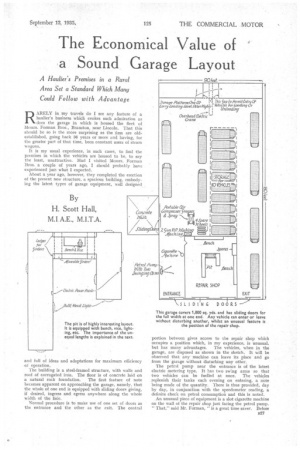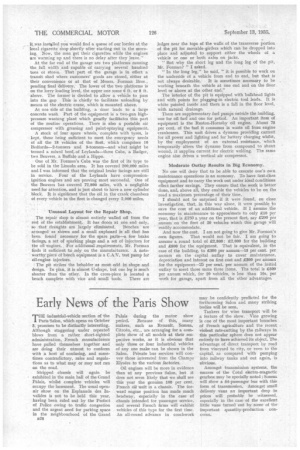The Economical Value of a Sound Garage Layout
Page 37

Page 38

If you've noticed an error in this article please click here to report it so we can fix it.
A Haulier's Premises in a Rural Area Set a Standard Which Many Could Follow with Advantage
RARELY in my travels do I see any feature of a haulier's business which evokes such admiration as does the garage in which is housed the fleet of Messrs. Forman Bros., Branston, near Lincoln. That this should be So is the more surprising as the firm are oldestablished, going back 36 years or more and having, for the greater part of that time, been constant users of steam wagons.
It is my usual experience, in such cases, to find the premises in which the vehicles are housed to be, to say the least, unattractive. Bad I visited Messrs. Forman Bros. a couple of years ago, I should probably have experienced just what I expected.
About a year ago, however, they completed the erection of the present new structure, a spacious building, embodying the latest types of garage equipment, well designed
and full of ideas and adaptations for maximum efficiency of operation.
The building is a steel-framed structure, with walls and roof of corrugated iron. The floor is of concrete laid on a natural rock foundation. The first feature of note becomes apparent on approaching the garage, namely, that the whole of one end is equipped with sliding doors giving, if desired, ingress and egress anywhere along the whole width of the face.
Normal procedure is to make use of one set of doors as the entrance and the other as the exit. The central portion between gives access to the repair shop which occupies a position which, in my experience, is unusual, but has many advantages. The vehicles, when in the garage, are disposed as shown in the sketch. It will be observed that any machine can leave its place and go from the garage without disturbing any other.
The petrol pump near the entrance is of the latest electric metering type. It has two swing arms so that two vehicles can he fuelled at once. The vehicles replenish their tanks each evening on entering, a note being made of the quantity. There is thus provided, day by day, in conjunction with the speedometer reading, a definite check on petrol consumption and this is noted.
An unusual piece of equipment is a slot cigarette machine on the wall of the repair shop just facing the petrol pump. " That," said Mr. Forman, " is a great time saver. Before
it was installed you would find a queue of our lorries at the local cigarette shop shortly after starting out in the morning. Now, the men get their cigarettes while the engines are warming up and there is no delay after they leave," At. the far end of the garage are two platforms running the full width and capable of carrying several hundred tons of stores. That part of the garage is in effect a transit shed where customers' goods are stored, either at their convenience or at that of Messrs. Forman Bros., pending final delivery. The lower of the two platforms is on the lorry loading level, the upper one some 6 ft. or 8 ft. above. The former is divided to allow a vehicle to pass into the gap This is chiefly to facilitate unloading by means of the electric crane, which is mounted above.
At one side of the building, a door leads to a large concrete wash. Part of the equipment is a two-gun high pressure washing plant which greatly facilitates this part of the routine operations. There is also a portable air compressor with greasing and paint-spraying equipment. A stock of four spare wheels,complete with tyres, is kept, these being sufficient to meet the emergency needs of all the 18 vehicles of the fleet, which comprises 10 Bedfords-2-tonners and 3-tonners--and what might be termed a mixed herd of Leylands—three Cubs, a Badger, two Beavers. a Buffalo and a Hippo. • One of Mr. Forman's Cubs was the first of its type to he sold in the Lincoln area. It has covered 200,000 miles and I was informed that the original brake facings are still in service. Four of the Leylands have compressionignition engines and are proving most successful. One of the Beavers has covered 72,800 miles, with a negligible need for attention, and is just about to have a new cylinder block. It is significant that the oil in the crank chambers of every vehicle in the fleet is changed every 2,000 miles.
• Unusual Layout for the Repair Shop. The repair shop is almost entirely walled off from the rest of the establishment. It has doors at one end only, so that draughts are largely eliminated. Benches • are arranged as shown and a small cupboard is all that has been found necessary for the spare parts—a few brake facings, a set of sparking plugs and a set of injectors for the oil engines. For additional requirements, Mr. Forman finds it sufficient to rely on the manufacturers. A noteworthy piece of 'bench equipment is a C.A.V. test pump for oil-engine injectors.
The pit strikes the beholder as most odd in shape and design. In plan, it is almost tashape, but one leg is much shorter than the other. In the cross-piece is located a bench complete with vice and small tools. There are ledges near the tops of the walls of the transverse portion of the pit for movable girders which can be dropped into place and adjusted to support either the wheels of a vehicle or one or both axles on jacks.
" But why the short leg and the long leg of the pit, Mr. Forman? " I asked.
" In the long leg," he said, " it is possible to work on the underside of a vehicle from end to end, but that is not always desirable. It is sometimes necessary to be working beneath the vehicle at one end and on the floor level or above at the other end."
The interior of the pit is equipped with bulkhead lights and with points for plugging-in electric tool leads. It is white painted inside and there is a fall in the floor level, with natural drainage.
There are supplementary fuel pumps outside the hal lung. one for oil fuel and one for petrol. An important item of equipment is the Ruston-Hornsby oil engine. About 75 per cent. of the fuel it consumes is waste oil from engine crankcases. This unit drives a dynamo providing current for all power and lighting and for battery charging whilst, by the employment of an external resistance, which temporarily alters the dynamo from compound to shunt wound, it supplies current for electric welding. The same engine also drives a vertical• air compressor.
Moderate Outlay Results in Big Economy.
No one will deny that to be able to execute one's own maintenance operations is an economy. To have first-class equipment and to carry the work out under ideal conditions effect further savings. They ensure that the work is better done, and, above an, they enable the vehicles to be on the road a maximum percentage of their time.
I should not be surprised if it were found, on close investigation, that, in this way alone, it were possible to save the cost of an additional vehicle. If I assume the economy in maintenance to approximate to only £10 per year, that is £180 a year on the present fleet, say £200 per annum on the fleet of 20 vehicles which this garage will readily accommodate.
And now the cost. I am not going to give Mr. Forman's own figures. That would not be fair. I am going to assume a round total of 42,800: £2,000 for the building and £800 for the equipment. That is equivalent, in the case of the building, to £300 per annum-15 per cent. per, annum on the capital outlay to cover maintenance. depreciation and interest on first cost and £200 per annum for the equipment-2 per cent. per annum of the initial outlay to meet those same three items. The total is £500 per annum which, for 20 vehicles, is less than 10s. per week for .garage, apart from all the other advantages.




















































































